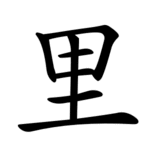

| 里 | ||||
|---|---|---|---|---|
| ||||
| 里 (U+91CC) "village, li (distance unit)" | ||||
| Pronunciations | ||||
| Pinyin: | lǐ | |||
| Bopomofo: | ㄌㄧˇ | |||
| Wade–Giles: | li3 | |||
| Cantonese Yale: | lei5 | |||
| Jyutping: | lei5 | |||
| Japanese Kana: | リri (on'yomi) さと sato (kun'yomi) | |||
| Sino-Korean: | 리ri | |||
| Hán-Việt: | lý, lí | |||
| Names | ||||
| Japanese name(s): | 里/さと sato (Left) 里偏/さとへん satohen | |||
| Hangul: | 마을 maeul | |||
| Stroke order animation | ||||
 | ||||
Radical 166orradical village (里部) meaning "village"or"li" (a traditional Chinese unit of distance) is one of the 20 Kangxi radicals (214 radicals in total) composed of 7 strokes.
In the Kangxi Dictionary, there are 14 characters (out of 49,030) to be found under this radical.
里 is also the 157th indexing component in the Table of Indexing Chinese Character Components predominantly adopted by Simplified Chinese dictionaries published in mainland China.
In Simplified Chinese, 裏or裡 which mean "inside" is merged to 里.
| Strokes | Characters |
|---|---|
| +0 | 里 (also SC form of 裏/裡 -> 衣) |
| +2 | 重 |
| +4 | 野 |
| +5 | 量 |
| +11 | 釐 |
The radical is also used as an independent Chinese character. It is one of the Kyōiku kanji or Kanji taught in elementary school in Japan.[1] It is a second grade kanji[1]
|
Chinese radicals according to the Kangxi Dictionary
| |
|---|---|
| 1 stroke |
|
| 2 strokes |
|
| 3 strokes |
|
| 4 strokes |
|
| 5 strokes |
|
| 6 strokes |
|
| 7 strokes |
|
| 8 strokes |
|
| 9 strokes |
|
| 10 strokes |
|
| 11 strokes |
|
| 12 strokes |
|
| 13 strokes |
|
| 14 strokes |
|
| 15 strokes |
|
| 16 strokes |
|
| 17 strokes |
|
See also: Kangxi radicals | |
|
Simplified Chinese characters radicals (indexing components)
| |
|---|---|
| 1 stroke |
|
| 2 strokes |
|
| 3 strokes |
|
| 4 strokes |
|
| 5 strokes |
|
| 6 strokes |
|
| 7 strokes |
|
| 8 strokes |
|
| 9 strokes |
|
| 10 strokes |
|
| 11 strokes |
|
| 12 strokes |
|
| 13 strokes |
|
| 14 strokes |
|
| 17 strokes |
|
GF 0011-2009 Table of Indexing Chinese Character Components prescribes 201 principle indexing components and 100 associated indexing components (in brackets) used in Simplified Chinese. Not all associated indexing components are listed above. | |